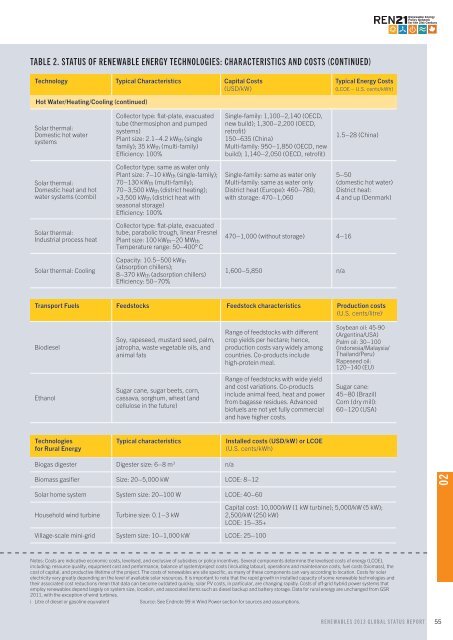RenewableS 2013 GlObal STaTUS RePORT - REN21
RenewableS 2013 GlObal STaTUS RePORT - REN21
RenewableS 2013 GlObal STaTUS RePORT - REN21
Create successful ePaper yourself
Turn your PDF publications into a flip-book with our unique Google optimized e-Paper software.
TABLE 2. Status of Renewable Energy Technologies: Characteristics and Costs (Continued)<br />
Technology Typical Characteristics Capital Costs Typical Energy Costs<br />
(USD/kW)<br />
(LCOE – U.S. cents/kWh)<br />
Hot Water/Heating/Cooling (continued)<br />
Solar thermal:<br />
Domestic hot water<br />
systems<br />
Collector type: flat-plate, evacuated<br />
tube (thermosiphon and pumped<br />
systems)<br />
Plant size: 2.1–4.2 kW th (single<br />
family); 35 kW th (multi-family)<br />
Efficiency: 100%<br />
Single-family: 1,100–2,140 (OECD,<br />
new build); 1,300–2,200 (OECD,<br />
retrofit)<br />
150–635 (China)<br />
Multi-family: 950–1,850 (OECD, new<br />
build); 1,140–2,050 (OECD, retrofit)<br />
1.5–28 (China)<br />
Solar thermal:<br />
Domestic heat and hot<br />
water systems (combi)<br />
Collector type: same as water only<br />
Plant size: 7–10 kW th (single-family);<br />
70–130 kW th (multi-family);<br />
70–3,500 kW th (district heating);<br />
>3,500 kW th (district heat with<br />
seasonal storage)<br />
Efficiency: 100%<br />
Single-family: same as water only<br />
Multi-family: same as water only<br />
District heat (Europe): 460–780;<br />
with storage: 470–1,060<br />
5–50<br />
(domestic hot water)<br />
District heat:<br />
4 and up (Denmark)<br />
Solar thermal:<br />
Industrial process heat<br />
Solar thermal: Cooling<br />
Collector type: flat-plate, evacuated<br />
tube, parabolic trough, linear Fresnel<br />
Plant size: 100 kW th –20 MW th<br />
Temperature range: 50–400° C<br />
Capacity: 10.5–500 kW th<br />
(absorption chillers);<br />
8–370 kW th (adsorption chillers)<br />
Efficiency: 50–70%<br />
470–1,000 (without storage) 4–16<br />
1,600–5,850 n/a<br />
Transport Fuels Feedstocks Feedstock characteristics Production costs<br />
(U.S. cents/litre) i<br />
Biodiesel<br />
Soy, rapeseed, mustard seed, palm,<br />
jatropha, waste vegetable oils, and<br />
animal fats<br />
Range of feedstocks with different<br />
crop yields per hectare; hence,<br />
production costs vary widely among<br />
countries. Co-products include<br />
high-protein meal.<br />
Soybean oil: 45-90<br />
(Argentina/USA)<br />
Palm oil: 30–100<br />
(Indonesia/Malaysia/<br />
Thailand/Peru)<br />
Rapeseed oil:<br />
120–140 (EU)<br />
Ethanol<br />
Sugar cane, sugar beets, corn,<br />
cassava, sorghum, wheat (and<br />
cellulose in the future)<br />
Range of feedstocks with wide yield<br />
and cost variations. Co-products<br />
include animal feed, heat and power<br />
from bagasse residues. Advanced<br />
biofuels are not yet fully commercial<br />
and have higher costs.<br />
Sugar cane:<br />
45–80 (Brazil)<br />
Corn (dry mill):<br />
60–120 (USA)<br />
Technologies Typical characteristics Installed costs (USD/kW) or LCOE<br />
for Rural Energy<br />
(U.S. cents/kWh)<br />
Biogas digester Digester size: 6–8 m 3 n/a<br />
Biomass gasifier Size: 20–5,000 kW LCOE: 8–12<br />
02<br />
Solar home system System size: 20–100 W LCOE: 40–60<br />
Household wind turbine<br />
Turbine size: 0.1–3 kW<br />
Capital cost: 10,000/kW (1 kW turbine); 5,000/kW (5 kW);<br />
2,500/kW (250 kW)<br />
LCOE: 15–35+<br />
Village-scale mini-grid System size: 10–1,000 kW LCOE: 25–100<br />
Notes: Costs are indicative economic costs, levelised, and exclusive of subsidies or policy incentives. Several components determine the levelised costs of energy (LCOE),<br />
including: resource quality, equipment cost and performance, balance of system/project costs (including labour), operations and maintenance costs, fuel costs (biomass), the<br />
cost of capital, and productive lifetime of the project. The costs of renewables are site specific, as many of these components can vary according to location. Costs for solar<br />
electricity vary greatly depending on the level of available solar resources. It is important to note that the rapid growth in installed capacity of some renewable technologies and<br />
their associated cost reductions mean that data can become outdated quickly; solar PV costs, in particular, are changing rapidly. Costs of off-grid hybrid power systems that<br />
employ renewables depend largely on system size, location, and associated items such as diesel backup and battery storage. Data for rural energy are unchanged from GSR<br />
2011, with the exception of wind turbines.<br />
i Litre of diesel or gasoline equivalent<br />
Source: See Endnote 99 in Wind Power section for sources and assumptions.<br />
Renewables <strong>2013</strong> Global Status Report 55




